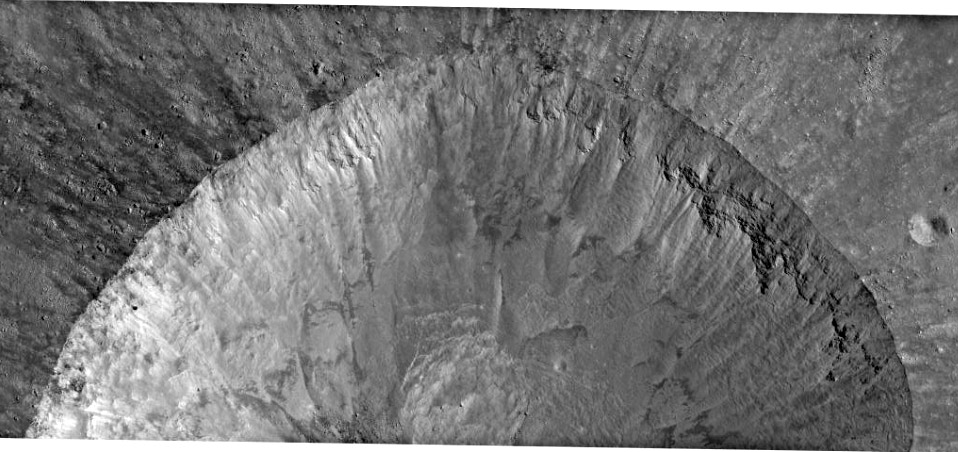Difference between revisions of "June 7, 2011"
| (5 intermediate revisions by the same user not shown) | |||
| Line 1: | Line 1: | ||
__NOTOC__ | __NOTOC__ | ||
=Streaming Debris= | =Streaming Debris= | ||
| + | <!-- Start of content --> | ||
<!-- ws:start:WikiTextHeadingRule:0:<h1> --> | <!-- ws:start:WikiTextHeadingRule:0:<h1> --> | ||
<!-- ws:start:WikiTextLocalImageRule:6:<img src="/file/view/LPOD-Jun7-11.jpg/234726954/LPOD-Jun7-11.jpg" alt="" title="" /> -->[[File:LPOD-Jun7-11.jpg|LPOD-Jun7-11.jpg]]<!-- ws:end:WikiTextLocalImageRule:6 --><br /> | <!-- ws:start:WikiTextLocalImageRule:6:<img src="/file/view/LPOD-Jun7-11.jpg/234726954/LPOD-Jun7-11.jpg" alt="" title="" /> -->[[File:LPOD-Jun7-11.jpg|LPOD-Jun7-11.jpg]]<!-- ws:end:WikiTextLocalImageRule:6 --><br /> | ||
| − | <em>LRO NAC image from [http://wms.lroc.asu.edu/lroc_browse/view/M154893929LR | + | <em>LRO NAC image from [http://wms.lroc.asu.edu/lroc_browse/view/M154893929LR NASA/GSFC/Arizona State University]</em><br /> |
<br /> | <br /> | ||
| − | Remember the [ | + | Remember the [[October_8,_2006|version]] of this frame to see below the bouldery material unusual, thin veneers of landslide material that smoothes out underlying gullies and is crossed by bouncing boulder trains and more dark streamers. On the left this top area is bright, making the dark streamers more conspicuous. The top part of the streams is very roughly about the same level all around the crater wall, suggesting that it may be a layer originally at that level. On the upper left rocky dark streamers radiate away from the crater edge and a few are aligned with ones inside the crater. This is a fascinating feature and it will be intriguing to see if the dark streamers occur at about the same level on the other side of the crater.<br /> |
<br /> | <br /> | ||
| − | <em>[mailto:tychocrater@yahoo.com | + | <em>[mailto:tychocrater@yahoo.com Chuck Wood]</em><br /> |
<em>Warning: I will be at a meeting near Baltimore, Maryland until Friday evening and may not have a chance to do an LPOD every night.</em><br /> | <em>Warning: I will be at a meeting near Baltimore, Maryland until Friday evening and may not have a chance to do an LPOD every night.</em><br /> | ||
<br /> | <br /> | ||
<strong>Related Links</strong><br /> | <strong>Related Links</strong><br /> | ||
| − | Rükl plate [ | + | Rükl plate [https://the-moon.us/wiki/R%C3%BCkl_69 69]<br /> |
<br /> | <br /> | ||
| + | <p><b>Yesterday's LPOD:</b> [[June 6, 2011|Where Has the Earthshine Gone?]] </p> | ||
| + | <p><b>Tomorrow's LPOD:</b> [[June 8, 2011|Open the Pod Bay Doors Please Hal]] </p> | ||
<hr /> | <hr /> | ||
| + | {{wiki/ArticleFooter}} | ||
Latest revision as of 18:51, 13 October 2018
Streaming Debris

LRO NAC image from NASA/GSFC/Arizona State University
Remember the version of this frame to see below the bouldery material unusual, thin veneers of landslide material that smoothes out underlying gullies and is crossed by bouncing boulder trains and more dark streamers. On the left this top area is bright, making the dark streamers more conspicuous. The top part of the streams is very roughly about the same level all around the crater wall, suggesting that it may be a layer originally at that level. On the upper left rocky dark streamers radiate away from the crater edge and a few are aligned with ones inside the crater. This is a fascinating feature and it will be intriguing to see if the dark streamers occur at about the same level on the other side of the crater.
Chuck Wood
Warning: I will be at a meeting near Baltimore, Maryland until Friday evening and may not have a chance to do an LPOD every night.
Related Links
Rükl plate 69
Yesterday's LPOD: Where Has the Earthshine Gone?
Tomorrow's LPOD: Open the Pod Bay Doors Please Hal
COMMENTS?
Register, Log in, and join in the comments.



